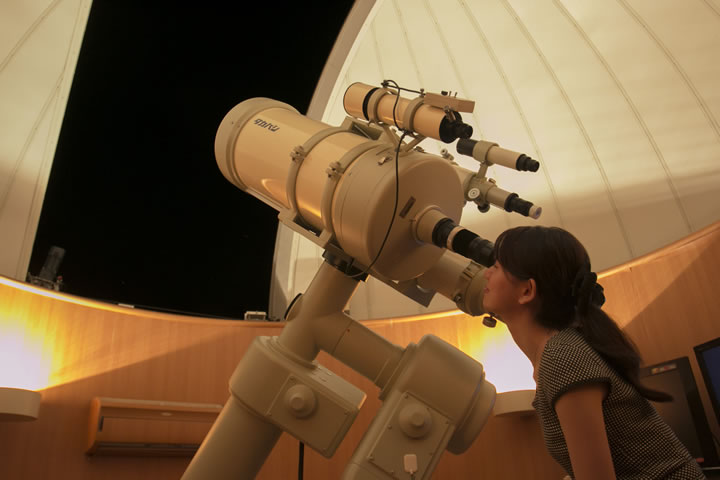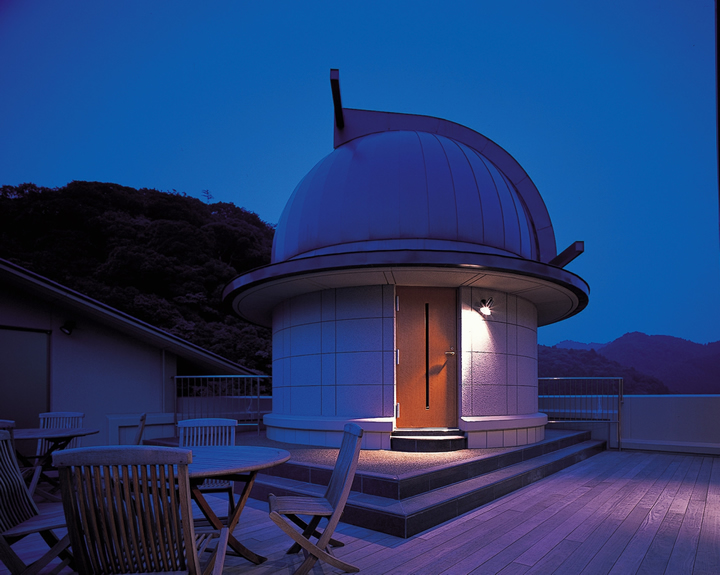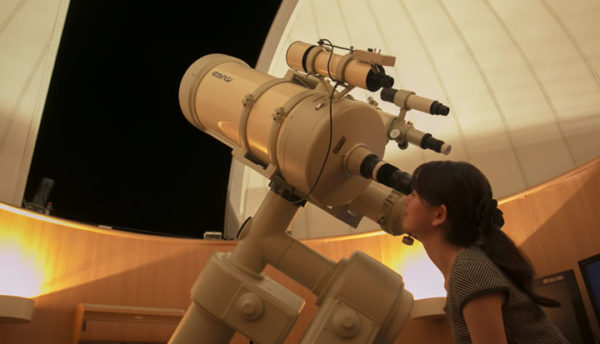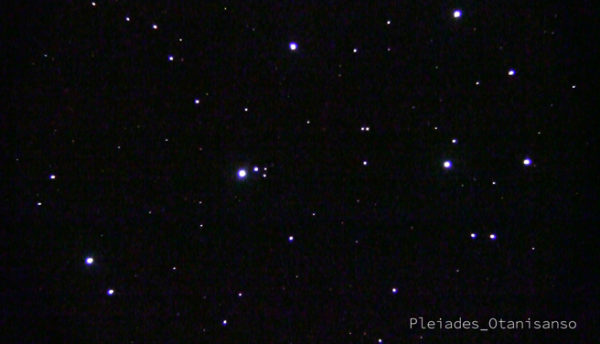- Astronomical Observatory
- 2021/08/29
【July in the Observatory】The Summer Triangle is the main figure of the Tanabata Star Festival. Take a look at first-class stars in the Milky Way from the telescope!
Observe Vega, which represents Princess Orihime, and Altair, which represents her lover Hikoboshi, according to legend, and Deneb, which connects the two.

Hello, this is the Otani Sanso Astronomical Observatory Dome. Today we’ll be discussing what’s visible in Nagato Yumoto Onsen’s night skies in July, 2021.
This month, we’ll once again be able to see Albireo in the constellation Cygnus and Antares in the contellation Scorpio in the Great Summer Triangle. The Great Summer Triangle is visible at night in spring, summer, and winter; and combined with the legend of Tanabata, the Star Festival, the Great Summer Triangle is especially well-known by many. Because all of its stars all strongly shining first magnitude stars, they’re fairly easy to see, even from the city. First, Vega, Princess Otohime’s star in the constellation Lyra, is the brightest of the three stars. The four stars lined up in a quadrangle beside it form the shape of a koto, a traditional Japanese stringed instrument. Because Vega’s apparent magnitude is 0.03, close to 0, Vega is used as a standard star against which other stars are measured to be of the same magnitude or not. In these cases, if Vega is a magnitude zero star, a celestial body with 1/100th the brightness would be considered a fifth magnitude star. In the plus mark-shaped constellation of Cygnus that seems to cut through the Milky Way, you can find Albireo and in the tail portion, Deneb. Because Deneb is some 1,400 light years away, it appears darker, about a 1.3 magnitude, but in reality it’s far larger than Vega, 200 times larger than the sun. And Altair, the star of Hikoboshi in the Tanabata legend, in the constellation of Aquila, is a 0.76 magnitude star. Across the Milky Way from Vega, you can find Altair at the bottom right of the Great Summer Triangle at around 9:30 p.m. In the legend of Tanabata, the two separated lovers these stars represent can meet just once a year, on July 7th, but Vega and Altair are actually separated by a distance of 15 light years, and while fairly close when compared with the Earth, it would still take 15 years to reach one another traveling at the speed of light. While the great summer stars often appear far away from one another, if you take a look at them through the telescope, they’re sure to feel much closer.
Legends related to the stars of July

What is the connection between Tanabata, the Star Festival, and making wishes?
Every year, as Tanabata draws close, even we at Otani Sanso decorate our lobby lounge with stalks of bamboo (the traditional decoration), and leave strips of paper for our guests to write their dearest wishes (it’s tradition for people to fasten their written wishes to bamboo stalks). Though this tradition doesn’t appear in the legend of Tanabata, it is said that it originates in the Chinese Festival to Plead for Skills. The star of Princess Orihime, which appears in Tanabata, is a star for the work of flag weaving, and ceremonies were held to pray to this star for superior sewing skills. It seems that people would hang their wishes as decoration from bamboo stalks, which were said to ward off bad fortune. Nowadays people write all sorts of wishes. How about writing one of your own to hang from the bamboo, as a promise to Vega in the constellation of Lyra?
Why is the Milky Way easier to see in the summertime?
The Milky Way is visible year-round, but why exactly is it said that it’s clearer to see during the summer than in other seasons? The Milky Way is in fact the galaxy to which our solar system belongs, as seen from the side. The galaxy is shaped like a disc, and its stars are especially concentrated together in the center, around which stars spread out thinly to the sides. In summer, the sky opens up to face the center of the galaxy, making the number of visible stars greater, but in winter, we face the side of the galaxy opposite its center, and as we’re only able to see the edge of the galaxy, the Milky Way looks thin to us. The center of the galaxy is located in the direction of Sagittarius, next to the constellation Scorpio, and is where the Milky Way appears the brightest. Try to take a look at it on the night of a New Moon, with little moonlight.
Information about the stars in July
July 1 (Thu) – 12 (Mon): The Great Summer Triangle, Albireo, Antares
July 13 (Tue) – 24 (Sat): the Moon, the Great Summer Triangle, Albireo, Antares
July 25 (Sun) – 31 (Sat): the Great Summer Triangle, Albireo, Antares, Saturn
Star-Gazing Topics in July
July 2 (Fri): Waning Quarter Moon
July 7 (Wed): Minor heat (beginning of third month of summer), Tanabata
July 10 (Sat): New Moon
July 17 (Sat): Waxing Quarter Moon
July 22 (Thu): Major heat (hottest period of the year), Marine Day
July 24 (Sat): Full Moon (Buck Moon)
July 31 (Fri): Waning Quarter Moon
Sunset occurs around 7:30 p.m. in Nagato.
Please check the National Astronomical Observatory of Japan website for sunset times in Yamaguchi Prefecture.
(See: National Astronomical Observatory of Japan Website))
When the rainy season seems to go on and on, even just a little bit of sunshine is a pleasure to see. There are some days when we may not be able to see through the telescope because of cloud cover, but in this event we will provide an explanation using past photographs, so please come and visit us at the Observatory Dome.
Making a Reservation at the Astronomical Observatory

Details
Observatory Hours…7:30 p.m. – 10:10 p.m.
Closed on… Every Tuesday
Location… Otani Sanso Roof (Just beside the gallery on the 8th floor)
Price… Free for overnight guests (Viewings available to those who reserve first)
Using the Observatory… Viewings are available to those who reserve first (12 seats per viewing)
※There is a limit on the number of people
Observation Times
7:30 p.m., 7:50 p.m. 8:10 p.m., 8:30 p.m.,
8:50 p.m. 9:10 p.m., 9:30 p.m., 9:50 p.m.
How to Make a Reservation
Please inform us of your desired reservation time from the times listed above (Please tell us via telephone, or write it in the “requests” field)
*You may not be able to participate in a viewing if a time slot is fully booked, or due to weather conditions.
*Should you be unable to participate in a viewing due to weather conditions, you will be able to see a video from a past viewing.
See details about the Astronomical observatory
■Frequently Asked Questions "Why is there an astronomical observatory on the roof of Otani Sanso?" The president of Otani Sanso, a great fan of the poems of Nagato/Senzaki-born Kaneko Misuzu, built the observatory out of a desire to "share the beautiful stars of Nagato with our guests, too." In fact, it was through a chance meeting via the Kaneko Misuzu Exchange Association that the president met with Dr. Haoru Saji, who greatly affected the president with the beauty of the stars he could see from the observatory at Tamagawa University even during the daytime. "There's much more than your eyes can see," Dr. Saji told him. "Let's take a look at the daytime stars." When you look up at the starry skies of Nagato, here, surrounded by nature, we hope you'll make memories to take home with you that you can look back on fondly.
Night Sky Trivia
The Speed of Light
- Light moves at a speed of approximately 300,000 km per second (7.5 revolutions around the Earth), and can cover 9.46 trillion km in a year.
- It takes light from the sun 8 minutes and 19 seconds to reach the earth.
- It takes 8 minutes and 19 seconds for light from the sun to reach the Earth.
Distances in Space
- Because space is so vast, we use “light years” and “astronomical units (AU)” to describe the distances between stars.
- 1 light year = the amount of distance light can travel in one year (9.5 trillion km)
- 1 astronomical unit = the distance between the sun and the Earth (approx. 150 million km)
Earth Time
- There are 24 hours in one day, but it takes 23 hours and 56 minutes for a rotation of the earth, leaving a margin of 4 minutes.
- The reason we have “leap years” is because the Earth’s orbital period around the sun is just shy of 365 Earth days.
- 1 rotation of the Earth (23 hours 56 minutes) = 400 m/sec
- 1 revolution of the Earth (365 days) = 30 km/sec
If you’d like to see more information about the night skies, the National Astronomical Observatory of Japan is extremely interesting. Please take a look.


